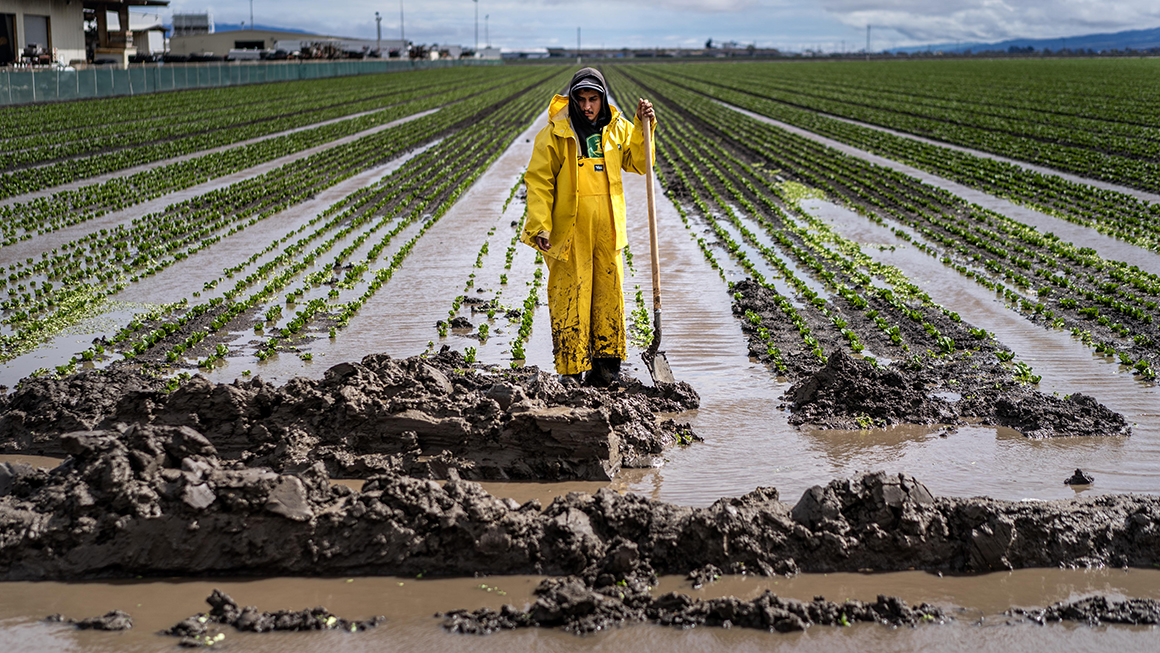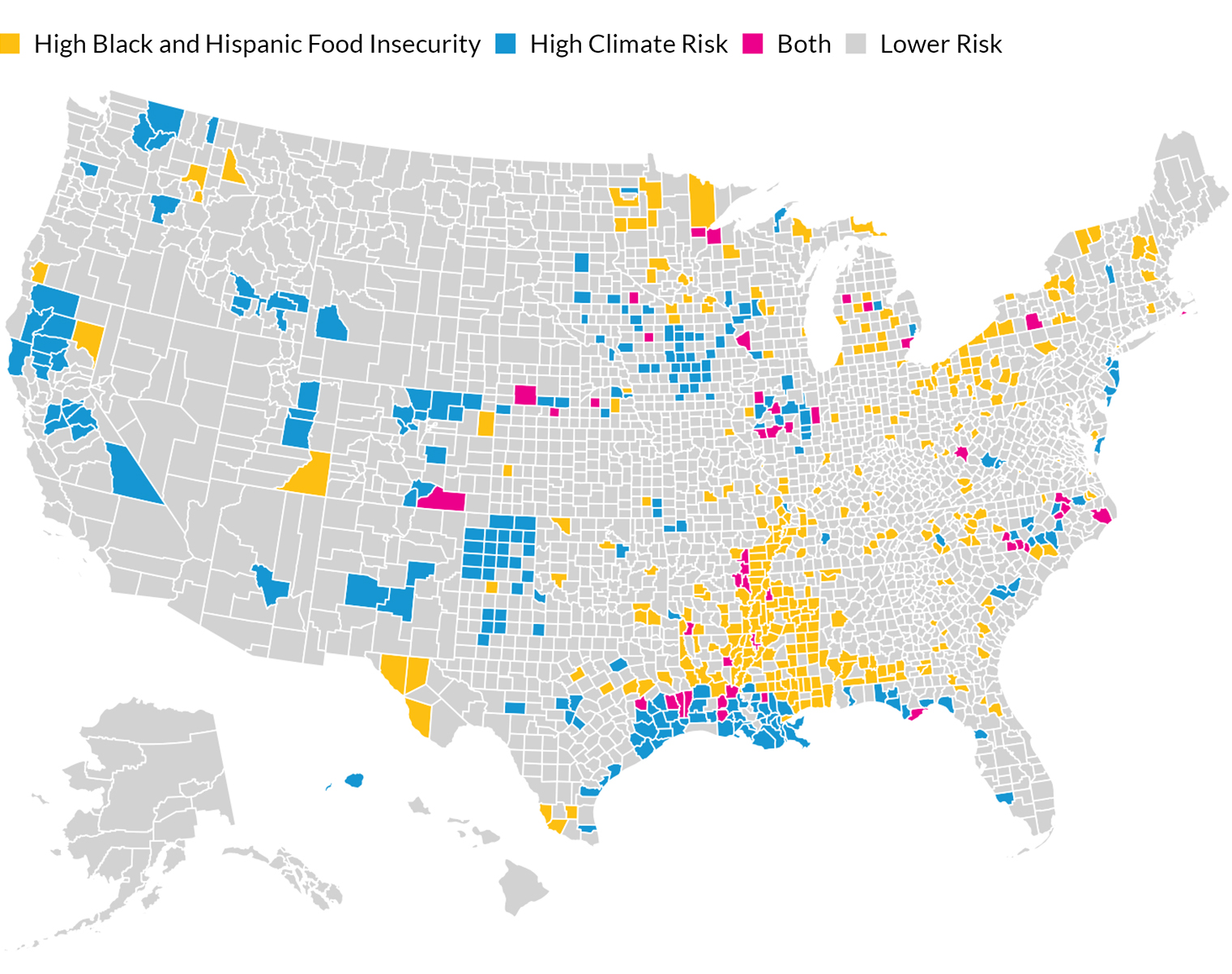
Resilient local food systems enable communities to weather disruptions and continue to produce and consume the food they need to live active and healthy lives. In the United States, globalization and economies of scale in the production and transportation of food has led to fractured local food systems that offer little overlap between production, distribution, and consumption. During the COVID-19 pandemic, supply chain disruptions exposed the risk of these divided and underdeveloped local food systems and foreshadowed the clear risk climate change–driven hazards can pose to local production and distribution.
Such climate risks may exacerbate racial and ethnic disparities (PDF) in agricultural production, food access, and food insecurity stemming from systematic disinvestment in communities of color, meaning residents who already struggle to meet their food needs will likely bear the brunt of the hazards.
To explore connections between racial equity, local food systems, and climate while engaging communities, the Racial Equity Analytics Lab, an Urban initiative that seeks to use data to address complex challenges in advancing racial equity, developed a pilot data tool that combines local-level data on climate hazards, food insecurity, agricultural production, and racial disparities. With this tool, we hope communities with overlapping challenges, policymakers, and other stakeholders can collaborate and accelerate evidence-based decisionmaking to strengthen local food systems.
Climate hazards could exacerbate disparities in food security and agricultural production
As climate hazards become more extreme, equitable adaptation requires accounting for differences in exposure and resources across communities. Following a disaster, communities of color tend to receive less Federal Emergency Management Agency recovery assistance (PDF) than affluent white communities, hindering their ability to rebuild. For an already food-insecure community, a hurricane that closes the one accessible grocery store could devastate households and worsen food access and security barriers, especially if that closure becomes permanent.
Farmers and ranchers of color, including Black, Latinx, and Indigenous producers, have encountered persistent barriers to obtaining investments to grow and adapt their farming operations in the face of climate disasters. Black farmers make up only 1.4 percent of the country’s agricultural producers (PDF), in large part because of decades of discriminatory lending practices and heirs’ property issues that make it harder for them to access capital. While it’s estimated that 78 percent of the agricultural workforce is Hispanic or Latinx, only 3 percent of farmers (PDF) identify as such. And Indigenous producers, including farmers and ranchers, contend with a long legacy of land theft and disruption of traditional foodways.
Many producers of color operate on a much smaller scale than traditional industrial agriculture, which limits their ability to make protective investments. Without intentional, proactive planning, damage from a major heatwave, drought, or storm could be catastrophic for a farm or ranch, increasing resilience gaps between white producers and producers of color.
Using local-level data to address the intersection between racial equity, food systems, and climate hazards
Counties with elevated climate risks from wildfires, droughts, and floods and high rates of food insecurity may face outsize challenges building and restoring resilient food systems. To help these areas amid growing climate threats, policymakers could prioritize policies designed to help local communities manage climate risks and better meet local food needs.
We find 47 counties across the US have high food insecurity among Black and Latinx families and high climate risk. Across these counties, we find the average amount of damage from climate disasters per capita for the past 10 years is $1,822, compared with $915 among all other counties that experienced climate events. Given the high costs of damages, many residents in these counties may face high burdens to reestablish financial security and may struggle to consistently meet their food needs. Areas in the Gulf Coast, Arkansas, North Carolina, and Illinois include several counties that face these intersecting risks and could benefit from additional policy supports to respond to and weather future climate hazards.
Nearly 50 US Counties Face High Intersecting Climate and Food Security Risks for Black and Latinx Residents
Counties in the top quintile of climate damages per capita and food insecurity rates for Black and Latinx residents

Source: Author’s calculations using data from Map the Meal Gap and Spatial Hazard Events and Losses Database (SHELDUS).
Notes: This map shows three measures: counties in the top quintile (20 percent) of food insecurity rates for Black and Latinx families combined (blue); counties in the top quintile in terms of total damages to property and crops over a 10-year period from floods, wildfires, and droughts (yellow); and counties in the top quintile for both climate hazards and food insecurity rates for Black and Latinx families combined (magenta). For this map, we use the combined food insecurity rate for Black and Latinx families from Map the Meal Gap and Craig Gundersen and data on climate damages from SHELDUS. Calculations for average dollar amounts of climate-related damages per capita are taken by averaging SHELDUS data over the applicable counties. For more information, please see: https://urban-institute.shinyapps.io/food-systems-clustering/.
These data are not just numbers on a page—they reflect real, community-level challenges and needs. Community-led organizations, such as the Black Farmer Fund, the National Black Food and Justice Alliance, the Native Land Information System, the Native Farm Bill Coalition, and the HEAL Food Alliance (as well as many others) have consistently raised issues of racial and ethnic inequities in food systems. As part of this project, we met with several community and equity-focused organizations to understand the data and tools they need to protect food-insecure communities and used their input to inform the development of our pilot data tool. Ultimately, the concerns of communities of color and their advocates need to be elevated and integrated into national climate and food system planning.
Policies and practices to support food system resilience should center racial equity for greater impact
Discussions of food system resilience, climate hazards, and racial equity are deeply interconnected but not often addressed holistically by policies and practices. Our pilot data tool can help decisionmakers begin to address the complex, interconnected challenges of food system resilience and inform responsive policymaking that is grounded in evidence.
Policymakers, practitioners, and researchers have opportunities to support equitable local food system resilience through the following:
- engaging with the US Department of Agriculture Equity Commission to inform a policy agenda for improving food insecurity and food system resilience to climate hazards, focusing on racial equity
- leveraging the Farm Bill to fund place-based investments in local food systems for communities facing outsize climate risks, including Indigenous communities and communities of color, with particular attention to smaller-scale farmers and producers who may lack the resources to pivot to new strategies or recover quickly from climate events
- engaging philanthropy in funding innovative approaches designed to address these intersecting conditions
- collaborating with communities and researchers to identify gaps in knowledge and tools that can help inform where investments may be needed
Researchers can partner intentionally with communities to explore topics that are of greatest value to them and address data gaps—especially those that affect communities of color—that make planning challenging at the local level.
To ensure local food systems can remain resilient to climate risks and serve everyone in their communities, policymakers, practitioners, and researchers—including us at Urban—should collaborate with communities to identify data gaps and solutions.
If this is an area of interest for you or your organization, if you have questions about the data or research, or if you’re interested in collaborating on this work, please reach out to: [email protected]